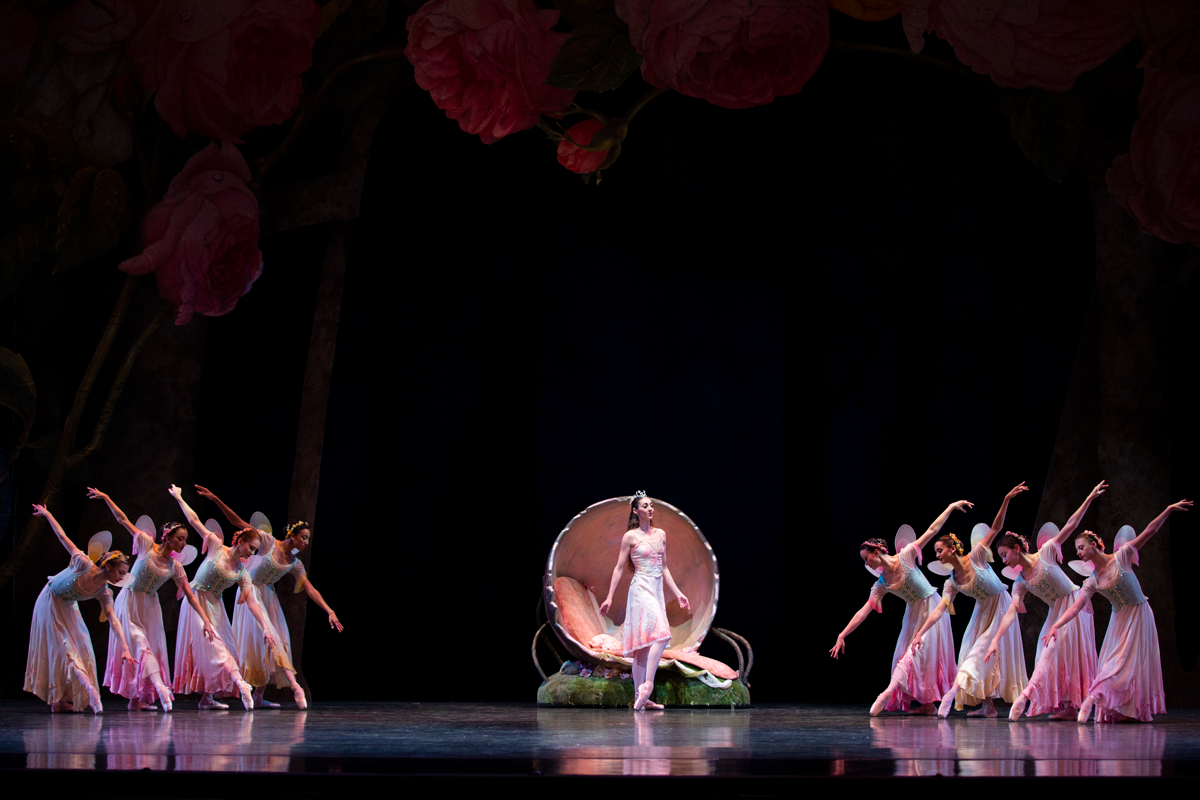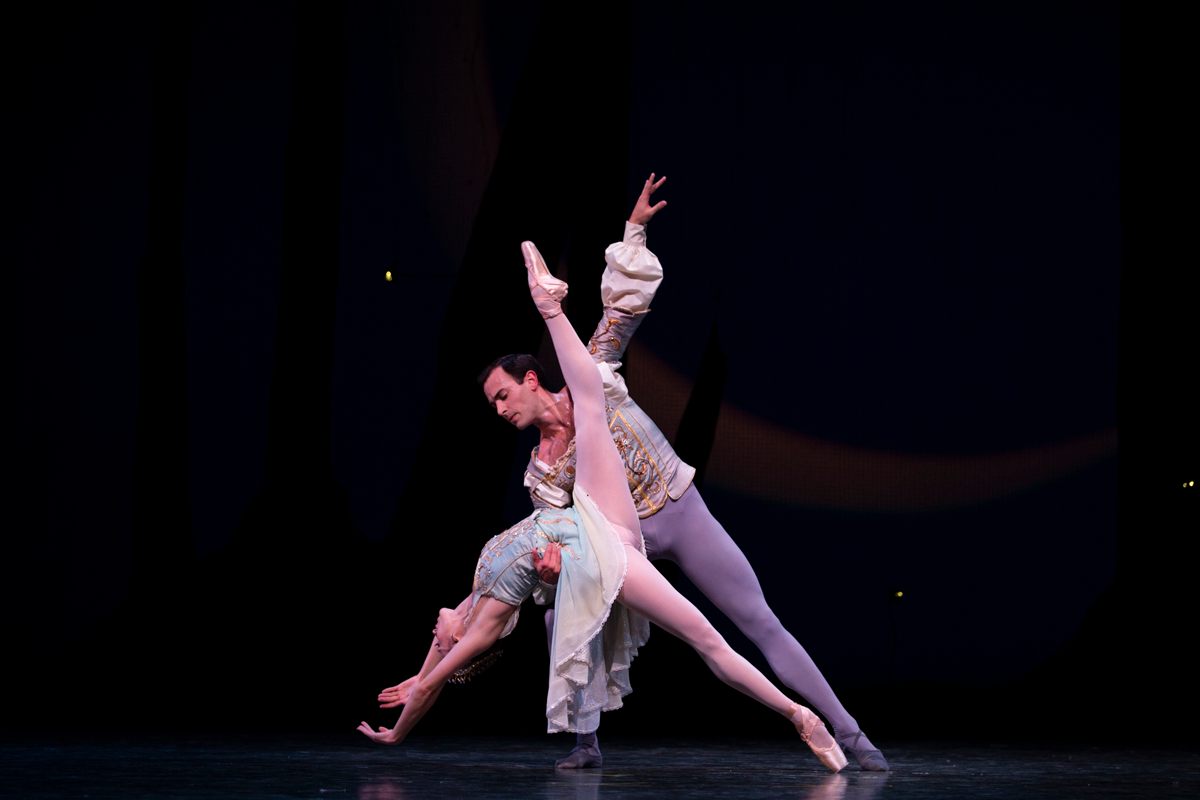A Midsummer (er… springtime?) Night’s Dream
by Jessika Anspach McEliece
The smell of sautéing onions wafted through the air as Classic FM streamed on my husband’s computer in our English flat (what the Brits call an apartment). All of a sudden, a familiar tune, Felix Mendelssohn’s Symphony No. 9 for Strings, filled our flat and beckoned my body to “mark” the movement it longed to dance once again. As if compelled by some crazy spell I passed the spatula to my husband. One moment I was cooking dinner and the next I was dancing the Divertissement from the second act of A Midsummer Night’s Dream in our tiny kitchen.
There are some ballets that the audience loves to watch, but the dancers don’t exactly love to dance. There are others that the dancers adore, but maybe the audience doesn’t quite get. And then there are those that stick with you – as a dancer, as an audience member – long after you leave the theater. Even years later. And you find yourself dancing in a kitchen in a different country.
George Balanchine’s A Midsummer Night’s Dream is one of these rare gems.

Months after retiring from a dozen years dancing for Pacific Northwest Ballet, my husband and I packed our bags and moved to a quintessential English countryside town so he could pursue his Master’s degree. We spent our weekends wandering through fairytale forests carpeted with bluebells, or exploring glorious English gardens, bursting with blossoms. I was also able to travel a bit, and made it down to see the Paris Opera Ballet’s redesign of the very same ballet PNB had redesigned two decades earlier: Balanchine’s Midsummer. And while the Christian Lacroix sets and costumes were brilliant, and the music and choreography like seeing a dear old friend, something felt missing, and made my heart ache for home and a life and career I’d left behind.
Two years later, Stateside and now with a 4-month old baby, my life couldn’t have been (or felt) more different than when I’d danced this beautiful ballet five years ago. But with dear friends dancing dream roles, it was one I certainly couldn’t miss – for them or for myself.
We dropped off our baby girl with her grandmother and I felt absolutely giddy as we drove away – not just because I got a date night with my husband (though don’t get me wrong… these days that’s pretty special too). No, it was because I was going to see a ballet that held such a huge piece of my heart.

Jessika Anspach McEliece as Helena with Kiyon Ross as Lysander in A Midsummer Night’s Dream; choreography by George Balanchine © The George Balanchine Trust; photo © Lindsay Thomas.
And as the four chords of Mendelssohn’s glorious overture announced the beginning of balletic trickery, drama & happily-ever-afters, I’ll be honest: I got a bit choked up. Memories came flooding back, of backstage shenanigans involving the bugs’ flicker lights, of butterflies – not onstage, but in my stomach, as I prepared to do Helena’s long walk – and of pure, incomparable joy.
The curtain rose to a woodland forest that looked strangely familiar to ones we’d walked in England, transporting me to a kind of children’s storybook filled with sprites, fairies and all the imaginary mischief they’re famous for. England was, after all, Shakespeare’s stomping ground. And Titania’s Bower, adorned with luscious roses and wildflowers, so reminded me of the countless English gardens we’d seen. Martin Pakledinaz certainly outdid himself in creating the sets and costumes for PNB’s production – something I didn’t fully appreciate till seeing it this time from the other side of the orchestra pit.

But the real stars of this production are Balanchine’s masterful choreography, Francia Russell’s meticulous staging, and the PNB dancers’ precise execution of the steps with the music, which is, in truth, the one perfect marriage in this whole ballet.
Balanchine’s comedic timing, particularly seen between the lovers (Helena, Hermia, Demetrius and Lysander), and also in the Donkey pas de deux, and Puck and Oberon’s interactions, is at the heart of this ballet. If one is even just slightly off the music, either early or late, the effect is completely lost. Yet when it’s accentuated and the parts are acted with just the right mix of drama and “cheese,” the dancers will have the audience literally LOLing…
But all the cheese and drama fade away as Act II approaches and the Divertissement dancers take the stage. The same marriage between steps and music is displayed, but not for comedic affect; rather, in sheer beauty and perfection. The pas de deux between the principal couple is the stuff little girls’ dreams are made of. Even as a grown woman who was blessed to dance many of these parts, I still sat on the edge of my seat, eyes wide and glimmering as I watched strength and grace embodied, hearing the voice in my heart whisper, “Can I do that when I grow up?”

And as the butterflies sang their final song and the curtain closed, I had to wipe the tears from my eyes. Happy tears. Because ballet can do that. It can embody beauty and inspire laughter, gratitude and joy – something our world desperately needs. At least it did that for me. I feel so thankful and blessed I got to be a part of this production then, and I get to be a part of it now. Because what good is a ballet, a story or a play without an audience?
So I implore you, be a part of THIS production. It is unlike any other and should not be missed.
GET TICKETS TO A MIDSUMMER NIGHT’S DREAM
ONSTAGE THROUGH APRIL 21, 2019 AT McCAW HALL
Header photo: Jessika Anspach McEliece in A Midsummer Night’s Dream; choreography by George Balanchine © The George Balanchine Trust; photo © Angela Sterling.






I’m an avid balletomane, and a many decades fan of PNB. I go to multiple performances of every program, and know all the dancers – often just by the way they move. So….yes, I love it. Jessica, I just want you to know that you may remember dancing at PNB, but many of us ALSO remember YOU dancing at PNB. You ARE remembered. For me you were always so dependable, so prepared, so lyrical….you were like a pillar holding up the very possibility of the dance, on that night, at that moment, in that music. I often watched just you, and if I think about it, my eyes were attracted to you because you seemed to love dancing so much. Just just danced…..nothing else. I missed you when you left, and I miss you now. Thanks for all those moments.